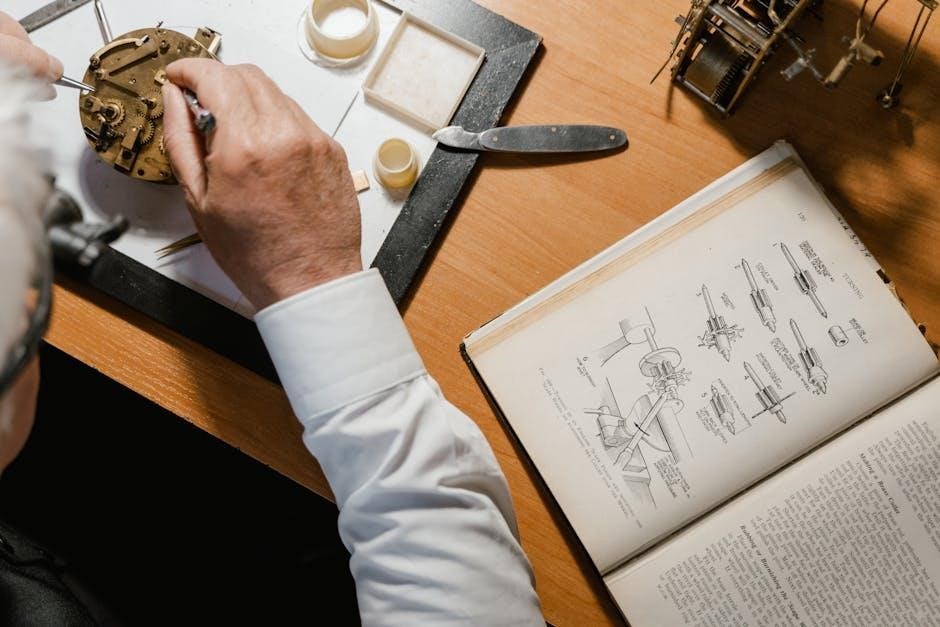adolescent/adult sensory profile pdf
Overview of the Adolescent/Adult Sensory Profile (AASP)
The Adolescent/Adult Sensory Profile (AASP) is a self-report questionnaire designed to measure an individual’s sensory processing patterns and their impact on daily life. It assesses responses to sensory stimuli across different contexts, offering insights into how sensory experiences influence behavior.

Purpose of the AASP
The primary purpose of the Adolescent/Adult Sensory Profile (AASP) is to evaluate an individual’s sensory processing patterns and how these patterns affect their functional performance in daily activities. The AASP helps identify how individuals respond to sensory events, providing valuable information for understanding their behavioral responses.
Specifically, the AASP aims to measure an individual’s preferences and reactions to a range of sensory stimuli, which can include auditory, visual, tactile, and olfactory experiences; By assessing these responses, the AASP aids in identifying potential sensory processing challenges that may contribute to difficulties in various aspects of life.
Furthermore, the AASP serves as a comprehensive assessment tool to determine whether sensory processing issues are contributing to performance challenges. Ultimately, the AASP helps professionals create targeted interventions and strategies to improve sensory processing and enhance overall well-being and functioning.
Age Range for the AASP
The Adolescent/Adult Sensory Profile (AASP) is specifically designed for use with individuals aged 11 years and older, encompassing both adolescents and adults. This broad age range makes it a versatile tool for assessing sensory processing patterns across different developmental stages. The AASP is particularly useful for understanding how sensory processing evolves from adolescence into adulthood.
Given that the transition from adolescence to adulthood involves significant neurological and behavioral changes, the AASP provides valuable insights into how sensory processing impacts this crucial period. It is suitable for young adults (ages 18-25) who may be experiencing sensory-related challenges as they navigate new social, educational, and occupational environments.
Therefore, the AASP’s applicability to a wide age range ensures that it can effectively assess sensory processing patterns in individuals experiencing diverse life circumstances and developmental stages beyond childhood.

AASP Administration: Self-Questionnaire Format
The Adolescent/Adult Sensory Profile (AASP) is administered as a self-questionnaire, meaning that individuals complete the questionnaire themselves, providing their own perspectives on their sensory experiences. This format relies on the individual’s ability to reflect on and report their responses to various sensory stimuli encountered in daily life. The self-report nature of the AASP makes it a relatively straightforward and efficient method of data collection.
Participants are presented with a series of items that describe common sensory experiences. They are then asked to indicate how frequently they respond in the manner described by each item. The questionnaire format is designed to be easily understood, allowing individuals to complete it independently, typically without the need for direct supervision or intervention from a trained professional.
This self-report approach offers a valuable perspective, capturing the individual’s subjective experience of sensory processing patterns. It is crucial to ensure the individual understands the questions.
Scoring and Interpretation of the AASP
The Adolescent/Adult Sensory Profile (AASP) is scored to provide insights into an individual’s sensory processing patterns; Responses from the self-questionnaire are tallied and converted into standardized scores, which are then used to determine the individual’s standing on four sensory processing quadrants. These quadrants represent different ways individuals respond to sensory input: Sensation Seeking, Sensation Avoiding, Sensory Sensitivity, and Low Registration;
The scoring process involves calculating scores for each of these quadrants based on the individual’s responses to specific items on the questionnaire. These scores are then compared to normative data to determine whether the individual’s sensory processing patterns fall within the typical range or deviate significantly. Interpretation involves understanding the implications of these scores in the context of the individual’s daily life and functional performance.
High scores in a particular quadrant suggest a strong preference for or avoidance of certain types of sensory input. Understanding these patterns can inform interventions.

Four Quadrants of Sensory Processing
The AASP identifies four distinct sensory processing patterns: Sensation Seeking, Sensation Avoiding, Sensory Sensitivity, and Low Registration. Each quadrant reflects unique behavioral responses to sensory stimuli, influencing how individuals interact with their environment.
Sensation Seeking
Sensation Seeking, as measured by the Adolescent/Adult Sensory Profile (AASP), characterizes individuals who actively seek out intense and varied sensory experiences. These individuals possess a high neurological threshold and engage in active behavioral responses to meet their sensory needs.
Those with a sensation-seeking profile often enjoy activities that provide a high degree of sensory input. This may include participating in extreme sports, attending loud concerts, or preferring brightly colored and stimulating environments. They are motivated by the thrill and excitement that sensory experiences offer, and actively pursue opportunities to engage their senses.
In daily life, sensation seekers might choose hobbies and activities that provide a constant stream of sensory stimulation. They may also be drawn to careers that involve novelty, adventure, and a high degree of sensory engagement. Understanding this profile can help tailor environments and activities to meet the needs of sensation seekers, promoting engagement and satisfaction.
Furthermore, recognizing a sensation-seeking profile can be beneficial in educational and therapeutic settings, enabling the development of strategies that harness their natural inclination for sensory exploration.
Sensation Avoiding
Sensation Avoiding, as identified by the Adolescent/Adult Sensory Profile (AASP), describes individuals who actively minimize sensory input in their environment. These individuals also have a low neurological threshold, meaning they perceive sensory stimuli more intensely, and they use active strategies to avoid overwhelming experiences.
People with a sensation-avoiding profile are easily overwhelmed by excessive sensory stimulation. They may find crowded places, loud noises, or bright lights to be uncomfortable or even distressing. To cope with this sensitivity, they actively seek to reduce their exposure to these types of sensory input.
In daily life, sensation avoiders might choose to wear noise-canceling headphones, prefer dimly lit environments, or avoid social gatherings with large crowds. They may also develop routines and habits that help them control their sensory experiences, such as eating familiar foods or wearing comfortable clothing.
Understanding this sensory profile can be helpful in creating environments and activities that are more comfortable and manageable for sensation avoiders. This may involve providing quiet spaces, reducing visual clutter, or offering alternative ways to participate in activities that might otherwise be overwhelming.
Sensory Sensitivity
Sensory Sensitivity, a quadrant identified by the Adolescent/Adult Sensory Profile (AASP), characterizes individuals with a low neurological threshold who passively notice and are bothered by sensory input. Unlike sensation avoiders who actively reduce sensory experiences, those with sensory sensitivity are more prone to passively reacting to their sensory environment.
Individuals exhibiting sensory sensitivity have heightened awareness of sensory stimuli and tend to notice details that others might miss. This heightened awareness can lead to discomfort or distress in environments with excessive or conflicting sensory information, such as strong smells, bright lights, or background noise.
This profile is defined by a low neurological threshold coupled with passive strategies. They don’t necessarily avoid stimuli like sensation avoiders, but they are easily overwhelmed by them. This sensory overload can manifest in various ways, including irritability, difficulty concentrating, or physical discomfort.
Understanding sensory sensitivity can aid in creating supportive environments by reducing unnecessary sensory input and providing strategies for managing sensory overload, such as taking breaks in quiet spaces or using calming techniques. Recognizing this profile helps to foster understanding and support for individuals experiencing the world with heightened sensory awareness.
Low Registration
Low Registration, as defined within the Adolescent/Adult Sensory Profile (AASP), describes individuals with a high neurological threshold who passively miss or ignore sensory input. Unlike sensation seekers who actively seek out sensory experiences, those with low registration tend to be less aware of their surroundings and may require stronger or more prolonged stimuli to notice them.
Individuals displaying low registration have a tendency to overlook or disregard sensory information that others readily perceive. This may result in them appearing withdrawn, inattentive, or disinterested in their environment. They may not respond to typical levels of sensory stimulation and may need more intense or repeated cues.
This profile is characterized by a high neurological threshold combined with passive behavioral responses. They don’t actively seek out sensory experiences, and they also don’t actively avoid them. Instead, they simply don’t register the sensory information as readily as others.
Understanding low registration can assist in modifying environments and providing support to enhance sensory awareness. Strategies may include using brighter colors, louder sounds, or more tactile experiences to engage their attention. Recognizing this profile helps facilitate communication and engagement by adjusting sensory input to meet their needs.

Applications in Mental Health
The Adolescent/Adult Sensory Profile (AASP) offers valuable insights within mental health settings by illuminating the connection between sensory processing patterns and mental well-being. Understanding an individual’s sensory preferences and sensitivities can significantly enhance therapeutic interventions and overall care.
By identifying specific sensory processing patterns, mental health professionals can tailor treatment approaches to address individual needs. For example, individuals with sensory sensitivities might benefit from strategies to manage sensory overload, reducing anxiety and promoting emotional regulation.
The AASP aids in identifying potential sensory-related triggers for emotional distress, enabling therapists to develop coping mechanisms and environmental modifications. Recognizing whether an individual is a sensation seeker, avoider, sensitive, or exhibits low registration provides a foundation for personalized interventions.
Furthermore, the AASP can assist in differentiating between sensory processing challenges and other mental health conditions, leading to more accurate diagnoses and targeted treatments. Integrating sensory considerations into mental health care promotes a holistic approach, acknowledging the impact of sensory experiences on emotional and psychological well-being, fostering greater self-awareness and improved quality of life for individuals.
Comparison to Sensory Profile 2
The Sensory Profile 2 (SP2) and the Adolescent/Adult Sensory Profile (AASP) are both instruments designed to assess sensory processing patterns, but they target different age groups. The SP2 is designed for infants, toddlers, children, and school-aged individuals (0-14 years), while the AASP is specifically for adolescents and adults (11 years and older).
The SP2 utilizes different forms tailored to each age range, often involving caregiver reports for younger children. In contrast, the AASP is a self-report questionnaire, relying on the individual’s own perceptions of their sensory experiences.
While both assessments explore similar sensory domains, the SP2 provides a more comprehensive evaluation for younger individuals, capturing nuances in sensory processing during developmental stages. The AASP focuses on the impact of sensory processing on daily life and functional performance in adolescents and adults.
The SP2 assists in identifying sensory processing difficulties in early childhood, enabling timely interventions. The AASP aids in understanding how sensory patterns affect academic, social, and occupational functioning in older individuals. Choosing the appropriate tool depends on the individual’s age and the specific goals of the assessment.



































